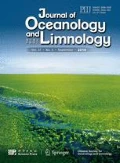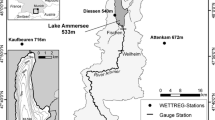Abstract
In this paper, we introduced parameterizations of the salinity effects (on heat capacity, thermal conductivity, freezing point and saturated vapor pressure) in a lake scheme integrated in the Weather Research and Forecasting model coupled with the Community Land Model (WRF-CLM). This was done to improve temperature simulation over and in a saline lake and to test the contributions of salinity effects on various water properties via sensitivity experiments. The modified lake scheme consists of the lake module in the CLM model, which is the land component of the WRF-CLM model. The Great Salt Lake (GSL) in the USA was selected as the study area. The simulation was performed from September 3, 2001 to September 30, 2002. Our results show that the modified WRF-CLM model that includes the lake scheme considering salinity effects can reasonably simulate temperature over and in the GSL. This model had much greater accuracy than neglecting salinity effects, particularly in a very cold event when that effect alters the freezing point. The salinity effect on saturated vapor pressure can reduce latent heat flux over the lake and make it slightly warmer. The salinity effect on heat capacity can also make lake temperature prone to changes. However, the salinity effect on thermal conductivity was found insignificant in our simulations.
Similar content being viewed by others
References
Ali H, Madramootoo C A, Gwad S A. 2001. Evaporation model of Lake Qaroun as influenced by lake salinity. Irrig. Drain., 50(1): 9–17.
Bennett N D, Croke B F W, Guariso G, Guillaume J H A, Hamilton S H, Jakeman A J, Marsili-Libelli S, Newham L T H, Norton J P, Perrin C, Pierce S A, Robson B, Seppelt R, Voinov A A, Fath B D, Andreassian V. 2013. Characterising performance of environmental models. Environ. Modell. Softw, 40: 1–20, http://dx.doi.org/10.1016/j.envsoft.2012.09.011.
Bonan G B. 1995. Sensitivity of a GCM simulation to inclusion of inland water surfaces. J. Climate, 8(11): 2 691–2 704.
Brock T D. 1975. Salinity and the ecology of dunaliella from Great Salt Lake. J. Gen. Microbiol., 89: 285–292.
Calder I R, Neal C. 1984. Evaporation from Saline Lakes—a combination equation approach. Hydrol. Sciences J., 29(1): 89–97.
Carpenter D M. 1993. The lake effect of the Great Salt Lake—overview and forecast problems. Weather Forecast, 8(2): 181–193.
Cohen P. 1989. The ASME Handbook on Water Technology for Thermal Systems. American Society of Mechanical Engineers, New York. 1900p.
Crosman E T, Horel J D. 2009. MODIS-derived surface temperature of the Great Salt Lake. Remote Sens. Environ., 113(1): 73–81.
Crump B C, Kling G W, Bahr M, Hobbie J E. 2003. Bacterioplankton community shifts in an arctic lake correlate with seasonal changes in organic matter source. Appl. Environ. Microb., 69(4): 2 253–2 268, http://dx.doi.org/10.1128/Aem.69.4.2253-2268.2003.
Diaz X, Johnson W P, Naftz D L. 2009. Selenium mass balance in the Great Salt Lake, Utah. Sci. Total. Environ., 407(7): 2 333–2 341.
Dickson D R, Yepson J H, Hales J V. 1965. Saturated vapor pressures over Great Salt Lake brine. J. Geophys. Res., 70: 500–503.
Diguilio R M, Teja A S. 1992. Thermal conductivity of aqueous salt solutions at high temperatures and high concentrations. Ind. Eng. Chem. Res., 31(4): 1 081–1 085.
Dudhia J. 1989. Numerical study of convection observed during the Winter Monsoon Experiment using a mesoscale two dimensional model. J. Atmos. Sci., 46(20): 3 077–3 107.
Flatau P J, Walko R L, Cotton W R. 1992. Polynomial fits to saturation vapor-pressure. J. Appl. Meteorol., 31(12): 1 507–1 513, http://dx.doi.org/10.1175/1520-0450(1992)031<1507:Pftsvp>2.0.Co;2.
Henderson-Sellers B. 1985. New formulation of eddy diffusion thermocline models. Appl. Math. Model., 9: 441–446.
Horel J, Splitt M, Dunn L, Pechmann J, White B, Ciliberti C, Lazarus S, Slemmer J, Zaff D, Burks J. 2002. Mesowest: cooperative mesonets in the western United States. B. Am. Meteorol. Soc., 83(2): 211–225.
Hostetler S W, Bartlein P J. 1990. Simulation of lake evaporation with application to modeling lake level variations of Harney-Malheur Lake, Oregon. Water Resour. Res., 26(10): 2 603–2 612.
Hostetler S W, Bates G T, Giorgi F. 1993. Interactive coupling of a lake thermal model with a regional climate model. J. Geophys. Res., 98(D3): 5 045–5 057.
Hostetler S W, Giorgi F, Bates G T, Bartlein P J. 1994. Lake-atmosphere feedbacks associated with paleolakes Bonneville and Lahontan. Sci., 263(5147): 665–668.
Kain J S. 2004. The Kain-Fritsch convective parameterization: an update. J. Appl. Meteorol., 43(1): 170–181.
Krinner G. 2003. Impact of lakes and wetlands on boreal climate. J. Geophys. Res., 108(D16), http://dx.doi.org/10.1029/2002jd002597.
Lofgren B M. 1997. Simulated effects of idealized Laurentian Great Lakes on regional and large-scale climate. J. Climate, 10: 2 847–2 858.
Long Z, Perrie W, Gyakum J, Caya D, Laprise R. 2007. Northern lake impacts on local seasonal climate. J. Hydrometeorol., 8(4): 881–896.
Low R D H. 1969. A generalized equation for the solution effect in droplet growth. J. Atmos. Sci., 26: 608–611.
Magnuson J J, Bowser C J. 1990. A network for long-term ecological research in the United States. Freshwater Biol., 23(1): 137–143.
Martynov A, Sushama L, Laprise R, Winger K, Dugas B. 2012. Interactive lakes in the Canadian Regional Climate Model, version 5: the role of lakes in the regional climate of North America. Tellus. A, 64, http://dx.doi.org/10.3402/tellusa.v64i0.16226.
Martynov A, Sushama L, Laprise R. 2010. Simulation of temperate freezing lakes by one-dimensional lake models: performance assessment for interactive coupling with regional climate models. Boreal Environ. Res., 15(2): 143–164.
McDonald M E, Hershey A E, Miller M C. 1996. Global warming impacts on lake trout in arctic lakes. Limnol. Oceanogr., 41(5): 1 102–1 108.
Mesinger F, DiMego G, Kalnay E, Mitchell K, Shafran P C, Ebisuzaki W, Jovic D, Woollen J, Rogers E, Berbery E H, Ek M B, Fan Y, Grumbine R, Higgins W, Li H, Lin Y, Manikin G, Parrish D, Shi W. 2006. North American regional reanalysis. B. Am. Meteorol. Soc., 87(3): 343–360, http://dx.doi.org/10.1175/Bams-87-3-343.
Mishra V, Cherkauer K A, Bowling L C. 2011. Changing thermal dynamics of lakes in the Great Lakes region: role of ice cover feedbacks. Global Planet Change, 75(3–4): 155–172.
Mlawer E J, Taubman S J, Brown P D, Iacono M J, Clough S A. 1997. Radiative transfer for inhomogeneous atmospheres: RRTM, a validated correlated-k model for the longwave. J. Geophys. Res., 102(D14): 16 663–16 682.
Mooij W M, Domis L N D S, Hulsmann S. 2008. The impact of climate warming on water temperature, timing of hatching and young-of-the-year growth of fish in shallow lakes in the Netherlands. J. Sea Res., 60(1–2): 32–43, http://dx.doi.org/10.1016/j.seares.2008.03.002.
Morrison H, Curry J A, Khvorostyanov V I. 2005. A new double-moment microphysics parameterization for application in cloud and climate models. Part I: Description. J. Atmos. Sci., 62(6): 1 665–1 677.
Naftz D L, Millero F J, Jones B F, Green W R. 2011. An equation of state for hypersaline water in Great Salt Lake, Utah, USA. Aquat. Geochem., 17(6): 809–820, http://dx.doi.org/10.1007/s10498-011-9138-z.
Noh Y, Cheon W G, Hong S Y, Raasch S. 2003. Improvement of the K-profile model for the planetary boundary layer based on large eddy simulation data. Bound — lay. Meteorol., 107(2): 401–427.
Notz D, Worster M G. 2008. In situ measurements of the evolution of young sea ice. J. Geophys. Res., 113: C03001, http://dx.doi.org/10.1029/2007jc004333.
Oleson K W, Dai Y, Bonan G, Bosilovich M, Dickson R, Dirmeyer P. 2004. Technical Description of the Community Land Model. http://www.cgd.ucar.edu/tss/clm/distribution/clm3.0/index.html.174p.
Oleson K W, Niu G Y, Yang Z L, Lawrence D M, Thornton P E, Lawrence P J, Stockli R, Dickinson R E, Bonan G B, Levis S, Dai A, Qian T. 2008. Improvements to the Community Land Model and their impact on the hydrological cycle. J. Geophys. Res., 113: G01021, http://01010.01029/02007JG000563.
Onton D J, Steenburgh W J A. 2001. Diagnostic and sensitivity studies of the 7 December 1998 Great Salt Lake-effect snowstorm. Mon. Weather. Rev., 129(6): 1 318–1 338.
Oroud I M. 1995. Effects of salinity upon evaporation from pans and shallow lakes near the Dead Sea. Theor. Appl. Climatol., 52(3–4): 231–240.
Ozbek H, Phillips S L. 1980. Thermal conductivity of aqueous sodium chloride solutions from 20 to 330°C. J. Chem. Eng. Data., 25: 263–267.
Perroud M, Goyette S, Martynov A, Beniston M, Anneville O. 2009. Simulation of multiannual thermal profiles in deep Lake Geneva: a comparison of one-dimensional lake models. Limnol. Oceanogr., 54(5): 1 574–1 594.
Skamarock W C, Klemp J B. 2008. A time-split nonhydrostatic atmospheric model for weather research and forecasting applications. J. Comput. Phys., 227(7): 3 465–3 485.
Small E E, Giorgi F, Sloan L C, Hostetler S. 2001. The effects of desiccation and climatic change on the hydrology of the Aral Sea. J. Climate, 14(3): 300–322, http://dx.doi.org/10.1175/1520-0442(2001)013〈0300:Teodac〉2.0.Co;2.
Steenburgh W J, Halvorson S F, Onton D J. 2000. Climatology of lake-effect snowstorms of the Great Salt Lake. Mon. Weather. Rev., 128(3): 709–727.
Steenburgh W J, Onton D J. 2001. Multiscale analysis of the 7 December 1998 Great Salt Lake-effect snowstorm. Mon. Weather. Rev., 129(6): 1 296–1 317.
Stephens D W. 1990. Changes in lake levels, salinity and the biological community of Great-Salt-Lake (Utah, USA), 1847–1987. Hydrobiologia, 197: 139–146, http://dx.doi.org/10.1007/Bf00026946.
Subin Z M, Riley W J, Jin J, Christianson D S, Torn M S, Kueppers L M. 2011. Ecosystem feedbacks to climate change in California: development, testing, and analysis using a coupled regional atmosphere and land surface model (WRF3-CLM3.5). Earth Interact., 15: 1–38, http://dx.doi.org/10.1175/2010EI331.1.
Sun H, Feistel R, Koch M, Markoe A. 2008. New equations for density, entropy, heat capacity, and potential temperature of a saline thermal fluid. Deep Sea. Res. I, 55: 1 304–1 310.
UNESCO. 1983. Algorithms for computation of fundamental properties of seawater (Access online via http://unesdoc.unesco.org/images/0005/000598/059832eb.pdf).
Wen L, Jin J. 2010a. Modeling and Analysis of the Impact of Great Salt Lake on Local Climate, paper presented at Spring Runoff Conference and Western Snow Conference, Logan, USA, Apr. p.20–21.
Wen L, Jin J. 2010b. Modeling of the impacts of the Great Salt Lake salinity on local climate with the Weather Research and Forecasting model, paper presented at The 11th WRF workshop, Boulder, USA, Jun. p.21–25.
Yusufova V D, Pepinov R I, Nikolaev V A, Guseinov G M. 1975. Thermal conductivity of aqueous solutions of NaCl. J. Eng. Phys. Therm., 29: 1 225–1 229.
Zeng X, Shaikh M, Dai Y, Dickinson R E, Myneni R. 2002. Coupling of the common land model to the NCAR community climate model. J. Climate, 15: 1 832–1 854.
Author information
Authors and Affiliations
Corresponding author
Additional information
Supported by the National Natural Science Foundation of China (No. 41130961), the Strategic Priority Research Program (B) of Chinese Academy of Sciences (No. XDB03030300), the National Natural Science Foundation of China (Nos. 41475011, 41275014), and the Visiting Scholars Program of the Public School Study Abroad Project of Chinese Academy of Sciences (No. 2008-No.136)
Rights and permissions
About this article
Cite this article
Wen, L., Nagabhatla, N., Zhao, L. et al. Impacts of salinity parameterizations on temperature simulation over and in a hypersaline lake. Chin. J. Ocean. Limnol. 33, 790–801 (2015). https://doi.org/10.1007/s00343-015-4153-3
Received:
Accepted:
Published:
Issue Date:
DOI: https://doi.org/10.1007/s00343-015-4153-3




